Voter List Maintenance - Fact SheetUpdated 7/14/25The SLO County Elections Office is responsible for ensuring accessible, accurate, and secure elections locally. This fact sheet highlights how elections officials conduct voter list (or voter roll) maintenance, the importance of accurate voter registration lists, and the National Voter Registration Act’s (NVRA) provisions to ensure voter lists are maintained. What is voter list maintenance? Voter list maintenance is the process election officials use to maintain accurate and up to date voter lists. It includes adding, updating, and removing voters from lists. Officials must follow appropriate state and federal laws to determine whether a voter should be removed from a list. Why is voter list maintenance important? Maintaining an accurate voter registration list is essential to protecting election integrity. Voters deserve an election system that produces an accurate result based on each eligible voter casting a single ballot in their proper jurisdiction. Maintaining an accurate voter list benefits voters because it lowers the likelihood of lines at the polls, reduces voter confusion, and decreases the number of provisional ballots. Updated records also allow the Elections Office to plan and better manage budgets and poll workers. What is the Help American Vote Act (HAVA) and the National Voter Registration Act (NVRA)? The Help America Vote Act (HAVA) was passed in 2002 and provides that states create a centralized computerized voter registration database that verifies registration information, conducts certain list maintenance functions, and interacts with local election voter registration databases at the county level. In California, this statewide centralized database is called VoteCal. The National Voter Registration Act (NVRA), commonly called the “motor voter” law because it contains provisions about voter registration at local DMV offices, was passed in 1993 and additionally provides guidance for when election officials may remove the name of a voter from a list. A voter may be moved from an inactive to a cancelled list of voters if no voter activity occurs for a period of two federal general elections. Other reasons for removal include death, specific criminal convictions if state law requires it, moving from one jurisdiction to another, mental incapacitation if state law requires it, or the voter’s own request. How does SLO County’s voter registration management system interact with VoteCal? To put it simply, you can envision a wheel with VoteCal as the hub and 58 individual county databases as the spokes. Vote Cal and SLO County share with each other updates that they receive from various government agencies and from voters themselves, ensuring that each has access to updates made on either end in near real-time. Here’s a graphic that illustrates the relationship between individual voters, VoteCal, SLO County, and various government agencies that provide updates that impact voter registration.
Why does the county’s number of registered voters fluctuate? Voter registration lists are always changing. The list of currently registered voters grows when voters move into the county, register for the first time, and turn 18. The list shrinks when voters move out of the county, pass away, or experience a felony conviction or declaration of incapacity. In fact, the numbers fluctuate many times within a single day. What makes a voter’s registration inactive? Under California Elections Code, a voter’s registration is designated inactive when:
Importantly, a voter with inactive status is still registered but will not receive mailed election materials unless they contact their local elections office or the California Secretary of State. By law, an inactive voter registration may be canceled if the voter doesn’t vote in two consecutive federal general elections. Do states automatically share and cross-check voter list information? The short answer is no. Each state makes its own determination about how best to maintain an accurate voter registration list. The NVRA does permit states to use uniform and non-discriminatory practices to ensure the accuracy of these lists, including using mechanisms to check information across states. However, there is currently no single resource used throughout the country to cross-check voter registration data. What other sources do election officials use to ensure accurate voter lists? California uses government records to check the accuracy of their voter lists. Examples include DMV records, death records from health departments or the Social Security Administration, specific disqualifying criminal convictions from courts, USPS Change of Address data, and notices from other election officials. Are voter lists public? No, voter registration information is confidential and lists are not public. However, voter information may be provided to a candidate for office, a ballot measure committee, or other person for election, scholarly, journalistic, political, or governmental purposes, as determined by the Secretary of State. Interested parties must submit an application for voter registration information. How can I check the status of my own voter registration? If you have questions about your own voter registration status, you can check https://voterstatus.sos.ca.gov/ or contact the Elections Office at [email protected] or (805) 781-5228. |
 County of San Luis Obispo
County of San Luis Obispo
Clerk-Recorder's Office
Voter List Maintenance Fact Sheet
